- 21 September 2016
- Asia
Social Studies Singapore
Friday, January 20, 2017
Economic expectations for Sg: 2016 with US changes
https://sg.finance.yahoo.com/news/singapore-expect-now-trump-president-034815104.html
This is What Singapore Can
Expect Now That Trump is President
Now that
Donald Trump is the U.S. president, the world will now see if he was all rice
and no chicken on the campaign trail. If he does follow through on everything
he promised to do, Singapore will be one of the countries impacted the most.
This is
because Singapore’s economy relies on trade like few other nations on earth.
This is shown by the total trade as a percentage of GDP number – the higher the
number, the more open a country is to international trade… and the more
important trade is to that country’s economy.
Trade
through Singapore accounted for 326% of the country’s GDP in 2015 – the
third-highest ratio in the world, after Hong Kong and Luxembourg. In fact, that
figure has been at 300% or higher for Singapore since 1976, according to data
from the World Bank (except for 1986 when it was 295%).
With that
in mind, here are three ways Singapore could be “trumped” by the new American
president.
- Less attention from the U.S.
The U.S.
is Singapore’s fourth-largest trading partner as measured by total trade
(imports plus exports). Trade between the two countries is dominated by the
exchange of different kinds of machinery and commercial services. The chances
are good that as President Trump focuses more on domestic matters, and on
alienating China, the U.S. government will pay less attention to the rest of
Asia. The days of President Obama’s so-called “Asia pivot” – entailing a
renewed and refreshed focus on the continent – are long gone.
- More trade with Asia
In
October 2015, the U.S. government signed the Trans-Pacific Partnership (TPP)
along with 11 other nations, including Singapore, Australia, Malaysia and
Japan. The TPP’s goal was to make it easier for the participating countries to
trade with each other by removing trade tariffs and lowering importing and
exporting costs between members.
But
Donald Trump said the TPP was “a terrible deal” for the U.S. Then, shortly
after winning the U.S. presidential election, Trump announced that one of the
first things he will do as president is withdraw from the TPP. Without U.S.
involvement, the deal is dead.
That
means easier access to the giant U.S. consumer market for countries like
Singapore will not get any easier. And if Trump starts imposing higher tariffs
on goods from Asia, it will slow down trade even further.
But soon
after Trump promised to withdraw from the TPP, Chinese president Xi Jinping
said that “China will not shut the door to the outside world but will open it
even wider.” In other words, China is set to fill the void left by the U.S.
easing up on globalisation. And it already has deals in place – all of which
involve Singapore – that could nearly match the TPP in size.
For
instance, China is a leading member of the Regional Comprehensive Economic
Partnership (RCEP). This is a trade agreement between the 10 ASEAN countries (which
includes Singapore) and the six countries with which ASEAN has existing FTAs –
this includes China, Australia, Japan and New Zealand.
This deal
is still being negotiated. If it happens, the RCEP will be a mega trade deal.
The 16 countries involved account for more than a quarter of global trade and a
quarter of global GDP. Plus, with China, India and Indonesia involved, it would
cover almost half of the world’s population.
China is
also developing the One-Belt, One-Road initiative, which is an effort to create
a modern-day Silk Road. The proposed infrastructure will more tightly connect
the continent of Asia to Europe and parts of Africa. One estimate suggests that
this will end up costing about US$8 trillion. It will allow China to trade more
easily with the majority of the world’s population.
Singapore
hopes to play a key role in this initiative. Not only is it a key part of the
Maritime Silk Road portion of the plan, but Singapore also hopes China will use
it as a platform to reach out to Southeast Asia and the rest of the world.
So even
with the potential of less trade with the U.S., Singapore could still benefit
from better trade relationships with its Asian neighbours.
- More uncertainty
It used
to be that in developed markets (like the U.S., Europe, and Japan), things were
comfortable and easy, and there weren’t many surprises. Politics didn’t matter
much to share prices.
And then
there were crazy emerging markets (like most of Latin America, Africa, and much
of Asia), the wild west of investing, where anything could happen. Bad politics
could erase years of market gains in a matter of moments.
When I
worked for a political risk consulting company a few years ago, we would talk
about how an emerging market was one where politics mattered to markets. That
meant that personalities (that is, the people in power) were bigger than, and
more important than, the institutions those people headed up. Who’s president,
what the parliament is doing, what kind of people are making policy – all of
that could be the difference between making or breaking a market.
And this
is still true in emerging markets, like Brazil and South Africa and Malaysia
and Russia. Who the president is and what crazy things he’s doing can
completely change the business and investment environment.
The big
change is that developed markets are looking a lot more like emerging markets
when it comes to politics. From Germany to Japan to the U.S., politics in many
developed markets are a lot more polarised than they’ve ever been before.
Different sides don’t want to talk – they only want to yell. And after a while,
a strong personality harnesses one part of this polarisation. That’s what can
threaten institutions. And that’s a big risk.
This is
what we see happening with the popularity of Donald Trump. Even in a developed
market like the U.S., personalities are becoming bigger than the institutions
they inhabit (like the presidency). If personalities can change those
institutions for the better, it’s a good thing. But it’s a big risk – as the
history of many countries in emerging markets has shown.
This type
of uncertainty in the world’s most developed market, the U.S., could translate
into more volatile markets everywhere. And that includes Singapore.
So with
Trump now in the White House, Singaporeans can expect to see more market
volatility, less interest from the U.S. and a bump in trade with the rest of
Asia.
Wednesday, September 21, 2016
Globalization: How did Disney get Moana so right and Maui so wrong?
How did Disney get Moana so right and Maui so wrong?
By Arieta Tegeilolo Talanoa Tora RikaFounder of talanoa.com.au
 Image copyrightDISNEY
Image copyrightDISNEY
A forthcoming Disney movie tells the story of Moana, a Polynesian girl who teams up with demi-god Maui to save her people. But some people have said the film and its merchandise are appropriating Samoan culture.
Arieta Rika, who founded a website called Talanoa as a home for Pacific stories, told the BBC how she wants her culture to be celebrated.
As a Pacific person, I can't tell you how excited I am to see this movie. Seeing faces that look like mine, telling a story that relates to me. I just don't have the words.
I haven't felt this excited about a Disney film in decades.
I am excited that the film has given a voice to many Pacific people who might have otherwise gone unheard when discussing issues about culture, people and place in the context of the Pacific and our stories.
It has also raised important questions about cultural appropriation and misappropriation. Is Disney doing it right?
Is there a way to celebrate Moana and Pacific culture, without offending Pacific people?
What is Moana?
- The second Disney film set in the Pacific Islands (after Lilo and Stitch, set in Hawaii)
- The story of a Polynesian girl who teams up with a Samoan demi-god Maui to go on a quest and save her people
- Maui - voiced by Dwayne Johnson, stage name The Rock - is based on a Polynesian legend
- According to myth, Maui created the Pacific Islands by fishing them from the sea
I've yet to watch the movie, but so far, it looks like Disney has applied four important aspects of Pacific culture: awareness, context, relationship and respect.
This week, Disney released a children's costume for Maui, a character in the Moana film. I get it - Disney knows and appreciates that children across the world will fall in love with Maui, and like many other Disney characters, they'll want nothing more than to look exactly like him.
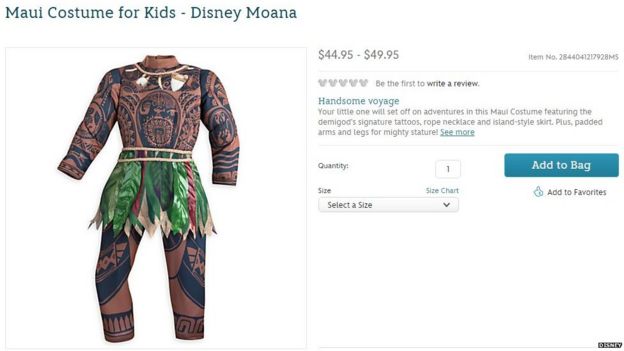 Image copyrightDISNEY
Image copyrightDISNEY
On paper, it seems like a pretty logical decision to create a costume.
There is not much to work with in terms of clothes though, as he only wears a grass skirt and a necklace made of shells. Hence the final product that Disney released - a body suit with brown skin, tattoos, Maui's necklace, and a grass skirt.
In reality, it has offended many Pacific people. I understand the reasoning behind the grass skirt and the necklace, but the brown skin is too far, and the tattoos are culturally misappropriated.
Tattoos are deeply meaningful to Pacific people. Like a fingerprint, a tattoo is unique to each person.
Our markings tell a personal story that we carry with us on our skin, everywhere we go - constantly reminding us of our values, our people, and our identity.
 Image copyrightGETTY IMAGES
Image copyrightGETTY IMAGES
It is considered taboo and extremely disrespectful in many Pacific cultures to wear the markings of a people or place that you are not spiritually or physically connected to. After the release of Moana, Maui may be a Disney character to some, but to many Pacific people, he is very real - a hero, ancestor, demi-God and a spiritual guide.
Even for Pacific people who don't believe in Maui, replicating a Polynesian tattoo and offering it to children for a price is belittling and trivializing an intimate aspect of Pacific people and culture.
Knowing this, Disney could have reconsidered their decision to include tattoos on Maui's costume. That would have also eliminated the need for the brown skin body suit that many consider "brownface". They also would have anticipated the backlash from Pacific people who interpret their decision as inappropriate and disrespectful at best - and at worst, a way to make money from a particularly significant aspect of Pacific culture.
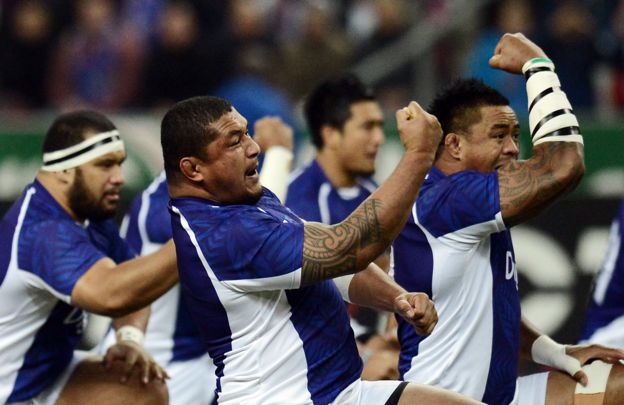 Image copyrightGETTY IMAGES
Image copyrightGETTY IMAGES
You need not be a Pacific person to enjoy and respect Moana, Maui and Pacific culture. Many Pacific people welcome questions. Taking initiative and starting these conversations creates trust, shows respect and ultimately, could be the start of a meaningful relationship between you and Pacific culture, and a Pacific person.
In the meantime, I will be eagerly waiting for the release of Moana. If anything, I appreciate the opportunity it is giving me and many other Pacific people to share our thoughts, our opinions, and our stories.
After all, having these conversations on a global scale is important, and it is what I and many Pacific people who have gone before me have been waiting for, for centuries.
Sunday, September 18, 2016
Charging your phone when the sun don't shine
How do you charge your phone when the sun doesn't shine?
By Tom JacksonTechnology of Business reporter
Seeing our mobile phone running low on juice can induce near panic in many of us these days - we've become so reliant on them.
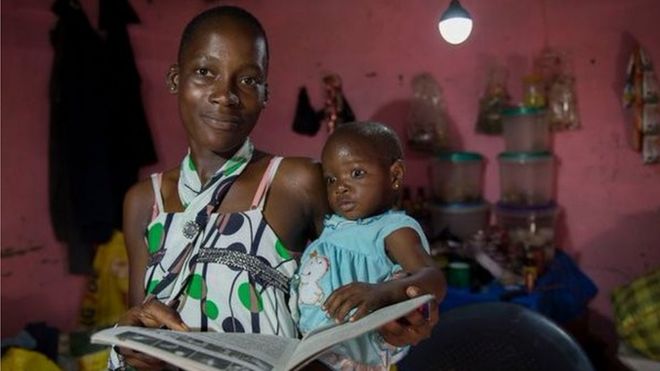
So imagine what it's like living in a remote village whose only electricity comes from solar power. What do you do when the sun doesn't shine?
Not only might your phone die, you might not have enough stored electricity to keep the lights on for more than a few hours. You have to light candles or a smelly kerosene lamp to see what you're doing at night.
But one solar power firm, Azuri, reckons it has an answer to this problem.
Its HomeStart system learns your electricity usage patterns and monitors climatic conditions to make sure the stored solar power is used in the most efficient way.
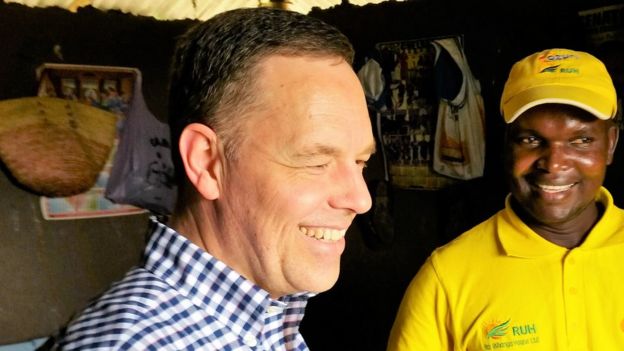 Image copyrightPEG GHANA
Image copyrightPEG GHANA
This can involve dimming lights to use less power and generally eking out the stored energy on less sunny days.
"Standalone solar home systems run until the power stored from sunshine during the day is exhausted, and then switch off," says Simon Bransfield-Garth, Azuri's chief executive.
"In poor weather, this may mean lighting time is reduced to just a few hours, forcing customers to revert to traditional means, such as harmful kerosene."
Health and education
The firm believes this is the first time machine learning has been applied to rural domestic solar power systems, and is an example of how innovation in the solar sector is helping "off-grid" households power up more efficiently across the continent.
New products are coming on to the market, including solar-powered fans, TVs and fridges.
One firm, Aleutia, provides a "solar classroom in a box", including solar panels, 10 rugged computers, a server, LED projector, and 3G and satellite networking equipment. It costs about $9,500 (£7,100).
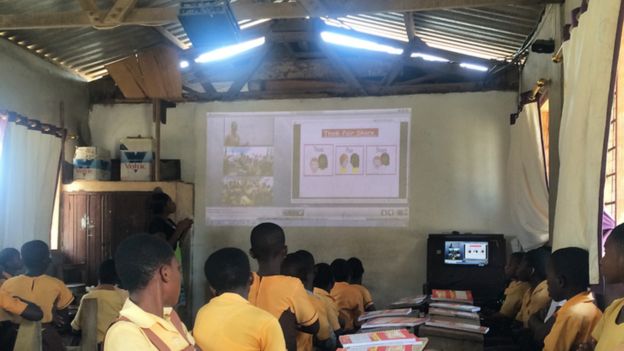 Image copyrightALEUTIA
Image copyrightALEUTIA
Aleutia has provided 137 schools in Uganda with computers and education software.
The company has also launched SolarEnabler, a "plug-and-play" box that provides everything you need for solar power in a wall-mounted box with constant 2G connectivity.
"Our computers are unique in their incredibly low energy consumption, which makes solar affordable," says Michael Rosenberg, Aleutia's chief executive.
It is making a big difference in rural primary health centres, he says.
"A single computer can register 800 patients a month, and record their symptoms and conditions. It is solar-powered hardware that provides transformative big data for health ministries."
Pay-as-you-go
Innovation in financing has also been key to the growing adoption of solar energy.
"Pay-as-you-go" and "rent-to-buy" schemes, pioneered by the likes of M-Kopa Solar and Azuri, are helping households pay off the cost of the solar kit over a manageable period.
Customers use mobile money services like M-Pesa to credit or top up their solar accounts.
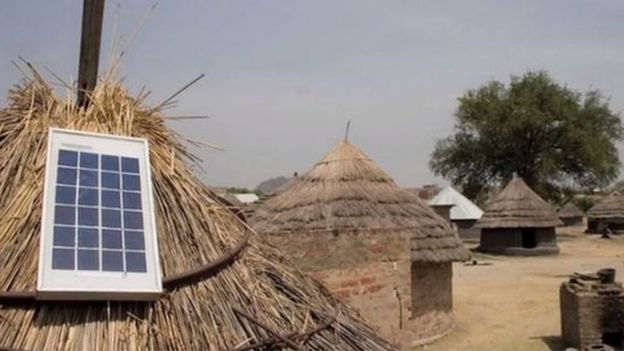 Image copyrightAZURI
Image copyrightAZURI
"Over the course of typically 18 months, the purchase of top-up pays off the cost of the solar home system," says Mr Bransfield-Garth.
"After this, the customer fully owns the system and can use it to access clean, renewable energy with no further cost."
Azuri, which launched in Kenya and has since expanded to other countries, has sold about 80,000 solar home systems so far.
Its entry level solar panel is a five-watt unit which, with plenty of sun beating down, provides users with about eight hours of lighting for two rooms and mobile phone charging.
 Image copyrightPEG GHANA
Image copyrightPEG GHANA
It costs about 220 Kenyan Shillings a week (£1.62; $2.17).
"Azuri's objective is to deliver clean and affordable power to enable rural Africans to realise their aspirations; lighting and mobile phone charging are just the starting point," says Mr Bransfield-Garth.
From light to credit
PEG Ghana, another solar power firm, has connected almost 15,000 homes in the West African country via a pay-as-you-go model and a kit made up of two lamps, a radio, a torch, and a mobile phone charger.
"We enable customers to replace their perpetual spending on poor-quality polluting fuels, such as kerosene, with solar energy that quickly becomes an asset the customer owns," says Nate Heller, chief executive of PEG Ghana.
 Image copyrightPEG
Image copyrightPEG
And the firm now offers customers who have paid off their solar units loans for other items, such as smartphones.
"Before you buy our product, you have a challenge to get anything on credit. You live in the middle of nowhere, you have no credit history, and no collateral," Mr Heller says.
"After you've paid off our system we have one year's worth of data on how you paid off the loan. Now we can give you loans for things like smartphones - you are a safe credit risk," he says.
Business case
But about 585 million people still lack access to electricity in Africa, according to the International Energy Agency, with only 14.2% of people in rural areas able to power their homes.
Even those with access to regular grid power can find it unreliable.
This leaves millions having to rely on kerosene, candles, battery torches or other fossil-fuel powered technologies.
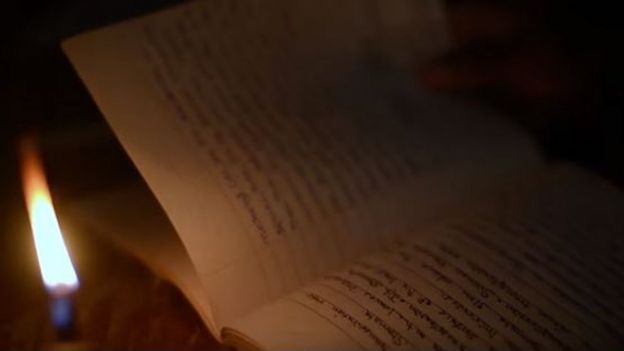 Image copyrightAZURI
Image copyrightAZURI
Across Africa and Asia, the 1.2 billion people who have no access to electricity spend about $27bn (£20.4bn) annually on these alternatives, says the BNEF Global Solar Market Trends Report 2016.
Solar power could save them a lot of money.
So the case for taking solar power into poorer communities is not just a social policy issue, says Xolani Mncedane, senior research analyst at the consultancy Frost & Sullivan Africa.
There is now a "compelling business case", he says. "The market is more affordable and more appealing.
"Solar home systems and solar-diesel hybrid systems are becoming economical, thereby presenting new opportunities, new business approaches and new financing models," concludes Mr Mncedane.
Subscribe to:
Posts (Atom)

